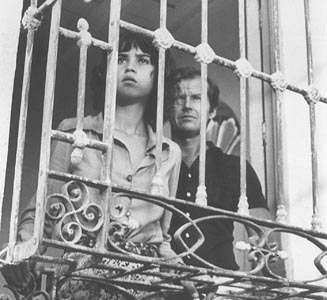![[MetroActive Movies]](/movies-arts-entertainment/gifs/movies468.gif)
[ Movies Index | SF Metropolitan | MetroActive Central | Archives ]
Blow Up Again
The affluent angst of Antonioni
Dow Jones offers few more precipitous plummets than the fall of the stock of Michelangelo Antonioni during the past few decades. A song in the late-'60s musical Hair had a young filmmaker claiming he loved Antonioni--who'd say that today, especially in a musical? Budding filmmakers today prefer bruised knuckles to cold shoulders, and the Italian master of angst's work goes often quite unrevived. But whenever you see a movie about the uncommunicative rich, tight and unhappy in their well-appointed homes, or a film about couples who can't express their own uneasy emotions, remember that Antonioni was there first.
A thorough retrospective titled "Modernist Master: Michelangelo Antonioni" (Jan. 22-Feb. 4 at the Castro) charts nearly 40 years of the director's work. Antonioni's first films were, like the other major talents in postwar Italy, neorealist. His second movie, Nettezza Urbana (1948), was about a street sweeper, in fact. As one critic suggested, the Italian director's later films about the affluent were also neorealist, only neorealist about the upper class.
The two-week fest of Antonioni at the Castro revives both well-known and obscure films, including a picture not released in North America: Chung Kuo China, his 1972 documentary on China, later denounced by the government of the People's Republic. Another early film, 1955's Story of a Love Affair, offers a variation on themes from The Postman Always Rings Twice.
Naturally, the two-week Antonioni retrospective touches upon once-cult items: the swinging London anti-mystery, 1966's Blow Up; 1975's The Passenger (Professione: Reporter), starring Jack Nicholson as a journalist who slips out of his own identity; and 1961's La Notte, a portrait of well-off intellectual misery during a sleepless night in Milan. Perhaps best-known of them all is his trio of films with the feline Monica Vitti. All three represent a favorite subject of the director, as stated in his 1955 Le Amiche: "Every woman living with a man to whom she is superior is unhappy." Vitti is in this situation thrice: in 1961's The Eclipse; in 1964's Red Desert, in which a violently polluted landscape mirrors the story of a woman who sleeps outside her class; and Antonioni's breakthrough film, L'Avventura.
The euphoniously titled L'Avventura takes place on vacation, beginning as a boating party to Lisca Bianca, a barren rock in the Mediterranean. The women aboard aren't quite kept women, but neither are they really in their own keeping. During the visit to the island one member of the group, Anna (Lea Massari), vanishes without a trace. The missing girl's on-again, off-again lover, Sandro (Gabriel Ferenzetti), had quarreled with Anna before her disappearance. Sandro takes up quickly, with only a little shame, with the girl's friend Claudia (Vitti). On a vacation that's partly a search for Anna, partly a tryst for the two, the couple endures their denatured shame, emotionally fraught sex and sullen skies. Which all sounds like a bath in lemon juice, but it isn't; it's a trick of Claudia's good, simple nature that she falls hard for the self-loathing Sandro, and there's a short spell of fragile bliss before she wakes up to the sort of weakling he is. This breakthrough film is handsome in its use of the wide screen to show off Antonioni's marvelous eye. The volcanic deserts are a backdrop for domestic blistering, demonstrating "the director's patented walk through a continent of scenery ... the human figure isolated, posing in a vast, sinister, anonymous space," as Manny Farber described it.
It's a unique vision, but variations on it have fueled popular art, diluting its power. Still powerful, though, are Antonioni's inventive shots of a man and a woman hopeless, side by side, looking away from the camera: the opposite of the kiss. Antonioni's films are about entrapment, and this above all has helped chip away his cult in America. American audiences have a national prejudice, and I share it, that action can be taken to break up an emotional stalemate. Our other national myth, which I doubt is true, is that a place among the yachts and villas can be had by each of us someday, through enough sheer hard work. Antonioni's stages for his upper-class misery (especially the Hate Boat in L'Avventura) look as posh as posh can be. Pauline Kael's famously damning essay "The Come-dressed-as-the-sick-soul-of-Europe Party," condemning Antonioni's La Notte, pointed out that to Americans pining for a European vacation, modern Italy looks far more attractive than repellent. Surely bad news drives out good; Kael's essay obscures the fact that earlier this commonsensical critic loved L'Avventura and deemed it the best film of 1961.
As with other great 20th-century artists, Antonioni's art was bomb art; his films attempted to clear out the debris of years of romantic, commercial filmmaking. The litter has returned, thicker than ever--maybe an aftershock of Antonioni would knock some of the rubble back.
[ San Francisco | MetroActive Central | Archives ]
Copyright © Metro Publishing Inc.
![]()

Identity Crisis: Jack Nicholson and Maria Schneider in The Passenger
From the January 18, 1999 issue of the Metropolitan.